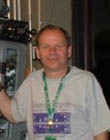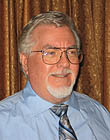|
|
This topic comprises 3 pages: 1 2 3
|
|
Author
|
Topic: why did so many theatres buy new projectors in the 1950s?
|
|
|
|
|
Monte L Fullmer
Film God

Posts: 8367
From: Nampa, Idaho, USA
Registered: Nov 2004
|
 posted 06-14-2012 12:56 PM
posted 06-14-2012 12:56 PM




The Simplex XL, which came out in 1950, was the main thing since it was such an evolutionary machine that it was like a new generation of manufacturing.
It featured the cone shutter that the shutter was very close to the aperture to give more crisp shutter action and eliminated light leakage around the shutter blade as with the older ones where the shutter was far back behind the aperture.
The XL was the first from Simplex to offer the curved gate to be used for larger lamphouses so to contain the dreaded focus drift that the straight gate variety was known for when used behind a big lamphouse. The curve just got the image that much close to the shutter.
The Intermittent assembly was a total joy to work on - you didn't have to split the case apart to change out a sprocket. You just took the end bearing off to replace and the unit was oiled by the main oiling assembly - not dependent of oil as with the earlier mechanisms.
Plus, it was self oiling and easy maintainable.
Unit was also designed for use in Drive-In's due to the usage of much larger lamphouses where the older ones couldn't take the heat and warped easily.
RCMH installed 5, Simplex XL Deluxe units using the Peerless Hycadecent, condensor carbon arc lamphouses to fill that 100ft wide screen from a 180 foot throw in the '50's.
The older Simplex units of the Super and E7 were manually oiled and the gearing in the back was a total pain to work on - esp. the E7 with that oblique shaft if you strip out a shutter drive gear.
Yet, on the plus side, a image being shown through an E7 or Super was rock steady if the rails in the trap were adjusted right, lateral guide roller was adjusted and a new intermittent sprocket. When CinemaScope came in, off went the front shutters, and if the attachments were on the heavy side, the lens holder assembly did suffer strain from the heavy lenses. This is where the XL took over with their very large lens barrel attachment assembly - it could handle the weight with no problem. The Century "SA" adopted the same lens barrel attachment for their units.
Also, Motiographs, with their barrel shutter, had problems with the shutter bearings since the units were greased, not oiled. Motiographs were a very durable machine, but the reflector setup for the lamphouse had to have a 'slow' focal to get that point of light thorugh the openings in the barrel to be the most effective. Some smaller lamphouse didn't work well due to the blades of the barrel would actually cut some of the light before going through the barrel and light efficency was reduced.
Century improved their "C" model with the "SA" series along with their soundheads and that added to the rollout of the older machines. The "SA" was called, "the Projectionist's Projector" being so strongly built, easy to work on and very dependable.
It was the 'digital' craze back then.
-Monte
| IP: Logged
|
|
Leo Enticknap
Film God

Posts: 7474
From: Loma Linda, CA
Registered: Jul 2000
|
 posted 06-14-2012 03:47 PM
posted 06-14-2012 03:47 PM





Two other factors I'm wondering about:
1 - Priority for war production being given to the raw materials (especially steel and aluminum) needed for projector manufacturing, meaning that routine projector replacements didn't happen during WWII, after which time it took a few years for production to resume and availability to become widespread;
2 - The transition from nitrate to acetate leading to fundamentally new designs that did not have to incorporate fire safety features (e.g. liquid cooled gates), but did incorporate features that the new technologies of the '50s called for, e.g. easily interchangeable lenses and aperture plates, and mag heads. So exhibitors wanted new features that spurred them into upgrading to a whole new projector, which previously they didn't need (and, due to the fragility of the post-war economy, couldn't afford).
The same thing can be seen here, too - there are a significant number of projectors from the late 50s still in use (or at least there were until the transition to digital really started to take off), notably DP-70s and GK-37s, but hardly anything from the '40s or earlier.
| IP: Logged
|
|
|
|
|
|
|
|
|
|
Jim Cassedy
Phenomenal Film Handler

Posts: 1661
From: San Francisco, CA
Registered: Dec 2006
|
 posted 06-14-2012 09:23 PM
posted 06-14-2012 09:23 PM




...and some day years from now people will be asking "why,
in the early 20th century, did theaters rip out perfectly
good film equipment and replace it with digital stuff?"
quote: Scott Norwood
Was this some sort of conspiracy among service companies to convince theatre owners that they needed new projectors
Well, I don't know what happened in the 1950's but I'm
100% convinced that the current digtial conversion frenzy
is a conspiracy between studios, equpment vendors & the
large theater chains to sell stuff & put small theater
out of business.
And if I really want to put on my "tin-foil-hat" I'd
swear the digtial projection equipment emits some sort
of mind numbing rays. How else could you explain the
mass-hypnosis that convinces theater owners that
installing this digital crap is actually a good idea?
It's certainly not a market-driven issue. I don't know
how forcing everyone to convert to digtial or go out
of business is not a violation of some sort of some
law. (Then again, I'm obviously not a lawyer)
For example- - one of the theaters I do some work for
has an primarily elderly clientle. Most of thse people
don't know the difference between an I-phone and an
Etch-A-Sketch. Or could care less. They don't really
givadamn if the picture they're watching is film or
digital. All they want is to see a show. For that
theater to spend amost $200,000 or so to put in digital
equipment just because the studios are too cheap to make
prints any more isn't worth it for them. They'll never
recoup that investment. So, they'll probably just close,
putting about a dozen people out of work and giving
the old people no place to go, except on Tuesdays when
they can all hang out at the KFC and get the bargin
chicken and corn cob dinner.
| IP: Logged
|
|
|
|
|
|
|
|
Leo Enticknap
Film God

Posts: 7474
From: Loma Linda, CA
Registered: Jul 2000
|
 posted 06-15-2012 06:41 AM
posted 06-15-2012 06:41 AM





Thinking a bit more about the 1950s issue, and I only have figures at my fingertips for Britain on this one, but would hazard a guess that the general argument holds...
The peak year for theatres operating was 1939, with 4,702 sites (almost all of them single screen, obviously). Other figures are 3,402 in 1928, 3,601 in 1931 and 4,406 in 1946 (the slight drop being accounted for by cinemas that were bombed and never re-opened, I'd guess). This would suggest to me that almost all the projectors in use by the early 1950s were either virtually new or significantly upgraded by the mid-1930s, i.e. after the dust had settled from the conversion to sound. From what I've read from trade press and secondary literature (e.g. Donald Crafton, The Talkies and Douglas Gomery, The Coming of Sound), some projectors were easily upgradable to sound (it depended what models you had and whether you wanted disc, film or both), whereas others weren't and the conversion meant getting new projectors. Keep in mind that even by the late '20s, many projectors were still hand-cranked, and as a general rule these weren't upgradable.
So during the 1940s, most projectors in use would only be around a decade old - not old enough to need end-of-life replacement. Plus, no new exhibition technologies had been rolled out during this period apart from very minor ones (e.g. readers for push-pull optical tracks) that would not have necessitated complete projector replacement. However, in the '50s, these technologies did come along - multiple aspect ratios (meaning that you needed projectors in which the lenses and plates could be swapped out quickly during a show - impossible with many pre-war designs), mag sound requiring the head mounted in a very specific place for the offset, and safety film enabling 6K reel lengths and eventually long-play systems to be used.
So as with sound in the 1930s, the 1950s gave exhibitors a reason to want new projectors; but during the '40s, no such reason materialised, the war created a hostile economic climate and most of the projectors around weren't old enough to need end-of-life replacement.
Just thinking out loud...
| IP: Logged
|
|
|
|
|
|
|
|
All times are Central (GMT -6:00)
|
This topic comprises 3 pages: 1 2 3
|
Powered by Infopop Corporation
UBB.classicTM
6.3.1.2
The Film-Tech Forums are designed for various members related to the cinema industry to express their opinions, viewpoints and testimonials on various products, services and events based upon speculation, personal knowledge and factual information through use, therefore all views represented here allow no liability upon the publishers of this web site and the owners of said views assume no liability for any ill will resulting from these postings. The posts made here are for educational as well as entertainment purposes and as such anyone viewing this portion of the website must accept these views as statements of the author of that opinion
and agrees to release the authors from any and all liability.
|

 Home
Home
 Products
Products
 Store
Store
 Forum
Forum
 Warehouse
Warehouse
 Contact Us
Contact Us




 Printer-friendly view of this topic
Printer-friendly view of this topic


















